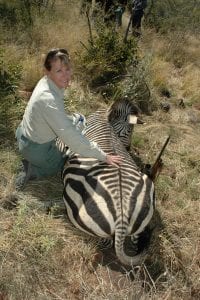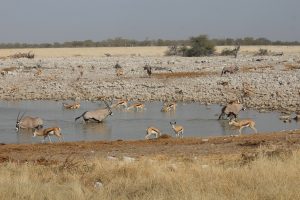The fascinating, complex, and intelligent behavior of animals never ceases to amaze us.
Photo above by Gary Kramer/garykramer.net
The hunting world is full of contradictions, some more visible than others. One of these is how often hunters, in private, share their wonder at the capacities, intelligence, and emotional expressions of wild animals, and how infrequently they do so in public. There certainly appears to be an unstated reluctance by hunters to acknowledge or celebrate the intelligence and emotional capacity of animals, especially when there is any likelihood the discussion will drift into a debate over the ethics of hunting itself. It seems there exists a deeply ingrained fear that discussing the shared capacities of humans and animals is a strategic mistake, and we might acknowledge that, yes, there really is some risk to this. But, will engaging in such discussions always unleash more criticisms of hunting? Isn’t it possible that demonstrating our careful study and acknowledgement of the complex lives of other animals might lead to a better understanding of hunting and hunters?
When we talk about the minds and emotions of animals, we usually refer to their sapience and sentience. These are technical terms but are easy to understand. Broadly speaking, sapience encompasses thinking and intelligence, whereas sentience represents the capacity to experience emotions and feelings. Advances in modern technologies, from radio-tracking devices to camera-equipped drones, have been exploding our understanding of both.
Every day we see news features that present us with incredible examples of the amazing thinking and emotional capacities animals of all kinds possess. The constant barrage of new observations into the private lives of animals, combined with scientific advances to probe ever deeper into their behaviors and relationships to other species, is leaving less and less room for those who see animals as fundamentally distinct from humans or driven solely in their behaviors by that catch-all term, instinct. The great seventeenth-century scientist and philosopher René Descartes may have been brilliant, but his belief that animals were machines and incapable of feelings has long been laid to rest.
Hunters need to recognize that the wider public is seeing animals as less and less different from humans, and it isn’t all Bambi’s fault. Through the magic of new technologies, we are all seeing with our own eyes what formerly was hidden from view by distance, darkness, or depth. Hunters must join with this new awakening or risk being out of step, once more, with social change. That, I suggest, is where the real risk lies; not in sharing our own fascination at the thinking and emotional capacities expressed by the animals we pursue. After all, our investment in observing wild animals in their natural state is exceptional by any social standard. Hunters and anglers spend more time trying to understand how animals behave than most people, by far, and are rewarded by experiences and observations that only a small segment of society will ever encounter. That knowledge is something to be celebrated, not hidden.
Many of us are familiar with methods commonly used to determine animal intelligence. Perhaps the most widely known involve mazes and/or boxes, which the animal must figure out in order to be rewarded with food. Sometimes this involves the animal needing only to navigate through a series of twists and turns, while other times it can involve multi-step processes whereby tools must be employed or repurposed, such as pushing a button or lever to access a reward. Another common test is the mirror test, in which animals are exposed to their own reflection in order to determine whether they understand the mirror to be showing them a reflection of themselves. There is truly no shortage of variation to the tests that scientists employ in their search to understand animal intelligence, and their findings have been remarkable.
While most of us have already heard about the intelligence of great apes, a growing body of evidence now points to the intelligence of a much broader array of species. For example, a study published last year revealed that New Caledonian crows are able to engage in complex puzzle-solving and can plan three steps ahead. In the test administered for this study, the crows had to select a short stick from a tube, which they then used to get a stone out of a second tube, which they could use to weight and depress a platform to get a piece of meat. This test revealed an astonishing level of problem-solving and strategizing on the part of the crows.
Outside the lab environment, researchers have also been able to identify intelligence markers by observing animal behaviors–sometimes very sneaky behaviors! For instance, researchers studying squirrels have determined that they are capable of engaging in tactical deception. When they have a nut in their possession and they are certain that they are being watched, squirrels will pretend to bury the nut, going through the entire process they normally would–digging the hole, refilling and patting it down–all the while keeping the nut hidden in their mouth to bury later when they are out of sight.
These are just a few examples of findings from recent studies of animal intelligence. In fact, this entire field of research is snowballing. Across the board, from large mammals to insects, scientists are proving more and more that the thought capacities of animals are far beyond what we had initially assumed, with creatures demonstrating incredibly sophisticated cognition. Indeed, a study of manta rays in 2016 revealed these creatures can pass the mirror test, demonstrating self-recognition, considered a high cognition capacity once thought limited to humans, chimpanzees, and dolphins. Viewed against a historic backdrop in which we consistently distinguished and distanced ourselves from all other animals, these findings are exciting for many, and certainly challenging for some. Almost every hunter I know, however, can relate their own observations of animal intelligence, striking behaviors they have witnessed and struggle to interpret.
Sapience, or intelligence, is only part of the story, however; we must also consider animal sentience. While intelligence has been tested and proven in a variety of species, measuring the emotional capacity of animals has proven a more nebulous target for researchers. Nevertheless, there has been a litany of scientific ventures across a number of disciplines, including many within the field of medical research, which shed new light on the emotional lives of animals. Findings reveal strong evidence in support of animals’ capacity to experience a diversity of positive and negative emotions, including joy, contentment, empathy, grief, sadness, fear, anxiety, anger, and jealousy.
Elephants, for example, have repeatedly been observed displaying grief and mourning over the loss of herd members. In 2016, a doctoral student studying African elephants released a video depicting how, after the death of a matriarch, three different families of elephants came to the site where she had died in order to touch her bones. While we may wonder at the motivations, few observing such behavior doubt that it indicates a sophisticated level of emotionality. Elephants have also been seen protecting the bodies of deceased loved ones from scavengers, standing watch and chasing away any predators that approach. These behaviors have extended to offspring, predictably, and to other members of the herd as well.
In July 2018, a killer whale gave birth to a calf off the coast of British Columbia only to have it die just half an hour later. Visibly distraught by the loss, the mother refused to let go and instead carried the 400-pound calf, keeping it at the surface of the water as she travelled more than 1,000 miles over a 17-day period. Following this journey, it appeared the mother finally accepted the death of her calf, and released it to the ocean depths. The whale’s journey was a media sensation and while some dismissed the unique observation as insignificant, many people, including experienced scientists, did not. Whatever the mechanism behind the mother’s behavior, one has to travel a long way to avoid calling it what we would if a human mother and child were involved: mourning.
Of course, to those of us who have a pet, these findings are unsurprising. When our dog greets us at the door, wagging his tail, we can see in his eyes and body language that he is happy to see us. Likewise, when he curls up next to us shaking as a thunderstorm rages outside, we know he is afraid and in need of comfort. When we ask him to sit, he understands and responds, but we know his intelligence goes far beyond learned commands. None of us needs a scientist to tell us our dogs are intelligent and can experience emotions; we see this firsthand every day. Nor do we need a psychologist to tell us how we feel about our dogs, or what human word best describes it. Why should we doubt that wild animals possess these same capacities?
I believe current research is only scratching the surface in our understanding of the lived realities of animals. To me, this is incredibly exciting. I am thrilled at the prospect of learning more about the intelligence and emotional lives of other species, and I am not alone. It is these rich, interconnected layers of existence that speak to the beauty and mystery which are the magic in our world, and in our lives afield. This is something hunters never stop admiring, and must always fight to conserve.
With this in mind, I stand firmly in support of legal, ethical hunting, and I believe this remains the most natural and humane manner in which we can participate in the complex circle of life. I love wildlife; I always have. But I also recognize that we, like every species, must make our way, and I believe we should do so as naturally as we can. Most hunters I know feel the same way. And this love goes far beyond the appreciation of wild meat to a deeper gratefulness for the entire natural system we seek to engage. Many of my fondest hunting memories are not of harvesting a wild animal; instead, they are of simply being in and around the hum and buzz of a wilderness alive with incredible creatures. In the end, what we hunt most is the experience of nature, of being sometimes amazed at our own frailties and always enthralled by the capacities of wild things.
As hunters and conservationists, let’s celebrate the beautiful and complex lives of all wildlife–those we hunt and those we simply admire–as we wander the wild places we all depend upon and enjoy. We can be excited about knowing wild species think and feel in ways much like ourselves. This does not mean we must somehow remove ourselves from participation in the drama of existence. However, it does mean that we may walk a little more humbly along the way.
The views expressed by the editors, authors or users of this linked article are expressly theirs, and do not necessarily reflect the policies or opinions of Dallas Safari Club, its employees, members or assigns. Any concerns about a site user’s post should be addressed appropriately to that person. Any concerns about an advertiser, a user or any content on this site should be addressed to social@dscnortheast.org.




